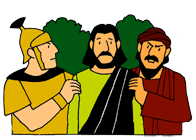 Scripture Reference:
Scripture Reference:![]()
Matthew 26:57-27:31
Suggested Emphasis: Jesus did not sin even when treated unfairly. We should please God in all we do and say.
Memory Verse: “If you are punished for doing wrong, there is no reason to praise you for bearing punishment. But if you suffer for doing good, and you are patient, then that pleases God.” 1 Peter 2:20, ICB
Story Overview:
After being arrested, Jesus was taken before a number of different religious and civil courts. He suffered false accusations and mistreatments at every level. The result was that Jesus was sentenced to die on a cross. While the trials were taking place, Peter denied Him, and Judas took his own life. Everything about the trial of Jesus and the surrounding events was unfair and sad, yet Jesus never strayed from His purpose.
Background Study:
Matthew, Mark, Luke and John all write about the trial of Jesus. Each writer approaches the events from a different angle and stresses different parts. Sometimes a writer places things in order of importance rather than chronologically. Each Gospel writer tells the story in the way he does in order to bring out something about the significance of Jesus and his death.
At the same time Jesus was on trial, other very sad events were taking place:
- Peter denied Jesus (Matthew 26:69-75; Mark 14:66-72; Luke 22:54-62; John 18:15-18, 25-27).
- Judas saw the consequences of what he had done and hung himself (Matthew 27:1-10). Acts 1:15-20 more graphically describes his end.
The Sanhedrin (The Jewish leadership)
The Sanhedrin consisted of three main groups. The “Chief Priests” included the ruling high priest (Caiaphas) and the former high priest (Annas, father-in-law to Caiaphas). The “elders” were lay members of the Sanhedrin. The “teachers of the law” were Jewish scholars of the day. Roman law limited the power of the Sanhedrin. The Sanhedrin was usually not allowed to carry out capital punishment.
Roman Government
Officials were appointed over regions to keep order among the many conquered nations living under Roman rule. Pontius Pilate was the Roman Governor of Judea (A.D. 26-36). His residence was in Caesarea on the Mediterranean coast, but he was in Jerusalem during Passover to prevent trouble from a large number of Jews assembled for the occasion. While there, he stayed in the magnificent palace built by Herod the Great near the temple. Mark refers to this palace as the “Praetorium” (Mark 15:16).
Herod Antipas was another governor. His main headquarters was in Tiberius on the Sea of Galilee, but, like Pilate, he had come to Jerusalem because of the Passover crowds
The Trials:
- Jewish Trial:
A preliminary hearing before Annas, the former high Priest (John 18:12-14, 19-23). Annas tried to get Jesus to admit to false teaching. He ended up having Jesus struck and then sent Him to Caiaphas. - The trial before Caiaphas, the High Priest, and the Sanhedrin (Mark 14:53-65):
They could not find any strong evidence against Jesus. Caiaphas finally bluntly asked Him if He was the Christ. Jesus answered, “I am.” This was considered blasphemy and worthy of death. He was blindfolded, struck with fists and beaten.
(Final Action of the Council ending all-night session (Mark 15:1). Jesus pronounced guilty, tied up again and sent to Pilate.) - Roman trial:
The trial before Pilate (Mark 15:2-5). Pilate considered Jesus a Jewish religious problem and not a civil one. He was amazed that Jesus did not defend Himself. When Pilate heard Jesus was from Galilee, he was happy to send Him off to Herod Antipas, who governed that region. Although the Mark passage does not record the time with Herod Antipas, it seems Pilate sent Jesus away only to have Him returned by Herod Antipas. - The trial before Herod Antipas (this is only recorded by Luke in Luke 23:6-12):
Herod had heard about Jesus and wanted to see a miracle. He and his soldiers mocked Jesus, put a robe on Him and then sent Him back to Pilate. - The trial before Pilate continued and concluded (Mark 15:6-15; Luke 23:13-25):
Pilate had no reason to give the death sentence that Jews wanted, but the crowd demanded crucifixion. Pilate gave the frenzied crowd the choice, and they chose a murderer to be released instead of Jesus. Pilate’s wife sent word to him that she was having dreams and Jesus was innocent. Finally, when Pilate saw that the crowd was turning ugly, he ceremoniously washed his hands of the situation. He had Jesus flogged and handed him over to be crucified.
The name “King Herod” appears a few times in the New Testament. Here are descriptions of three of them:
- Herod the Great- (37-4BC) King at the time of Jesus’ birth. Visited by the wise men. In an attempt to kill baby Jesus, he ordered Jewish boys under the age of two to be killed. Matthew 2:1-15
- Herod Antipas- (4BC-AD39) He put John the Baptist to death (Matthew 14:1-12). Pilate sent Jesus to him before His crucifixion (Luke 23:7-12).
- Herod Agrippa I- (AD 37-44) Killed James and had Peter thrown in prison. Struck down by an angel and eaten by worms (Acts 12:1-24).
Way to Introduce the Story:
Ask the children to talk about times when they might have been blamed for something they did not do. You might also wish to share your own experience if appropriate. Talk about how that felt. “In today’s story, we are going to learn about a time when Jesus was blamed for something He did not do.”
top
The Story:
Have you ever seen a picture of Jesus on the cross? Jesus was a good man, so who decided that He would die on the cross? How did this happen?
Today, let’s talk about how and why it was that Jesus came to die on the cross.
Before He died on the cross, Jesus spent time with His friends and the apostles. One evening they shared a special dinner together. Since it was the last time they ate together, this meal is called the “Last Supper.”
At the supper, Jesus told His friends that He would soon die. Jesus told them that even though they were His friends even THEY would all run away when He got into trouble.
The apostles did not believe this could ever happen. Peter told Jesus that there was no way he would ever leave Jesus. Jesus told him to just wait and see. He said Peter would deny Him three times before he heard the sound of a rooster crowing. Peter just couldn’t believe this could ever happen.
Later, Jesus went to a garden to pray, and soldiers came and arrested Him. They tied Him up and took Him to the religious leaders. First to Annas and then to Caiaphas. Some people and religious leaders told lies and said Jesus had done many bad things. They did not like that Jesus said He was the king of the Jews.
The religious leaders were so angry at Jesus that they decided to take Him to the Roman Governor and tell Him to have Jesus killed.
The Roman Governor was called Pontius Pilate. The religious leaders said to Pilate, “We demand that Jesus be crucified!”
“Crucified?” Pilate thought, “Only the worst criminals were ever punished by being put on a cross and crucified to die.” Pilate kept asking Jesus questions about what the religious leaders were saying, but Jesus did not even try to defend Himself.
Pilate didn’t really want to crucify Jesus, so he told them to take Jesus to another governor, Herod Antipas.
Herod Antipas only made fun of Jesus. He and his soldiers made a crown from thorns and placed it on Jesus’ head. They also put a robe on Him to make fun of Him for being called the king of the Jews.
While all of this was happening, where do you think Jesus’ friends were? Do you think they were trying to help Jesus?
No, they were just confused and afraid. Some people saw Peter and asked him if he knew Jesus. He was afraid that if he said he knew Jesus, then the people might hurt him just like they were hurting Jesus. So Peter denied he knew Jesus. Two other times, people noticed Peter and asked him if he knew Jesus. Each time he answered, “No.”
Finally, after the third time, guess what Peter heard? He heard a rooster crowing! It was just like Jesus said it would happen!
Meanwhile, Jesus had been sent back to Pilate. The Jewish leaders and many people kept demanding that Jesus be crucified.
Pilate did not like so many people being angry and shouting. He had an idea. Pilate brought out a really bad prisoner named Barabbas. He put this really bad man next to Jesus and asked the crowd to choose which one should be set free. Surely the crowd would say that Jesus should be set free! But no, the crowd was so angry that they began yelling for the bad man to be set free and for Jesus to be crucified.
Pilate had finally had enough. He let Barabbas, the bad man, go free.
Then Pilate called his soldiers. He said, “Take Jesus away. Beat His back with a whip and then put Him on a cross and leave Him there until he dies.”
Jesus has more power than Pilate, the angry people or even the soldiers. If Jesus had wanted to, He could have stopped everyone.
But Jesus did not stop them. He let the soldiers lead Him away; Jesus was thinking about everyone in the world who had ever done anything bad (sinned). Jesus loves everyone in the world very much!
EVERYONE who has ever sinned deserves to be punished. That even means you and me. But instead of letting everyone be punished, Jesus took one BIG punishment for all of us. Jesus died on the cross so that all of us could be forgiven of our sins instead of being punished for our sins.
And that’s how it happened that Jesus was sent to the cross.
Ways to Tell the Story:
This story can be told using a variety of methods. Always remain true to the facts found in the Bible but help children connect to its meaning by using drama, visual aids, voice inflection or other group participation.
Click here for visual aids and story-telling methods.
Click here to download the slideshow, or click here to download the pictures to print.
Each teacher is unique, so use only the illustrations that best relate to how you tell the story in this lesson. Too many illustrations can be confusing, so eliminate any that cover other stories or details you do not wish to emphasise in this lesson.
Additional illustrations are available at:
- http://www.freebibleimages.org/illustrations/ac-barabbas/ and
- http://www.freebibleimages.org/illustrations/jesus-trials/
Review and Reflection Questions:
Review questions help children remember and know the facts of a story, while reflection questions encourage them to internalize its meaning and implications for their lives. Asking at least one of each type of question can help strengthen a child’s spiritual development and help them connect to God. Click here to learn more about review and reflection questions.
Review:
- Which disciple denied knowing Jesus three times? (Peter)
- Did Jesus receive a fair trial? (No)
- What did Pilate’s wife say in her message to him? (She said she’d had dreams about Jesus being innocent. She told Pilate to not do anything to Jesus)
- Who wanted Jesus to be crucified? (The crowd of Jewish people)
- Who did the crowd set free from prison instead of Jesus? (Barabbas, a murderer)
- Which Roman governor sentenced Jesus to die? (Pontius Pilate)
- What did Pontius Pilate do before he sentenced Jesus to die? (He washed his hands to show that he wasn’t responsible for Jesus’ death)
- Why did Jesus not defend himself when He was on trial? (He knew He had to go to the cross, even if it was unfair)
- What did this story teach you about Jesus?
- What did this story teach you about people?
Reflection:
- How do you think Jesus felt while He was being questioned and accused in trials?
- How do you think Jesus felt when the soldiers made fun of Him and gave Him a crown of thorns?
- How do you think Peter felt when he realized he’d denied Jesus three times, just like Jesus had said would happen?
- Why do you think Pilate’s wife had dreams about Jesus being innocent?
- What do you think the crowd who wanted Jesus crucified looked or sounded like?
- How do you think Jesus felt when the crowd of people were shouting, “Crucify Him!”?
- Jesus was being treated unfairly, but He didn’t speak or act with anger towards those people. What do you think helped Jesus stay silent and obey God in this hard time?
- How do you think God feels when He sees us being treated unfairly?
- When we’re treated unfairly, what can we remember that will help us still obey God and love the people treating us unfairly? What can we do? (Suggestions: pray in that moment, ask the Holy Spirit to give you love and self-control, remember that God sees how you’re being treated, remember that those people may not know God loves them)
Prayer:
It is important to guide children in learning how to pray. In prayer, children can connect with God and learn that He hears and answers them. God can become a life-long friend who is with them every moment of their lives. Try using a variety of prayer methods from time to time so that the children can learn to connect with God in different ways. Note that you can pray at any time throughout your lesson. A variety of prayer methods are found here.
Song Suggestions:
- 1-2-3 The Devil’s After Me Song
- Oh, How I Love Jesus Song
- A great song from a church hymnal might be “I’ll Be a Friend to Jesus” or have someone teach the children.
- Refer to the Song Page on this website for more options.
Activities and Crafts:
(How to choose the best learning activities for my teaching situation)
Activities:
- Appoint a “judge.” The judge should ask the children to list all the things Jesus did right and then ask them to list what He did wrong. Discuss the fact that He did not do any wrong, but He suffered for us anyway (1 Peter 2:21-22).
- List situations where we might deny Christ (not tell friends we are Christians, etc.) Discuss how Peter must have felt. We will hear more about him later.
- Use large paper to draw scenes from today’s story. Assign each child a different scene. Use for review.
- Older children can use dramatic reading to read from the Bible. Find a dramatic reading example here.
- This lesson is one of several that tell the story of Jesus’ Death, Burial and Resurrection. These events are often grouped or taught together and called “The Passion Week.” If you or the children want to explore this group of events, you can look below at the related lessons:
 Invite the children to respond to this story using the adaptable “God’s Story” printable reflection page. Free printables for this story.
Invite the children to respond to this story using the adaptable “God’s Story” printable reflection page. Free printables for this story.
Crafts:
 Make a “fan” and remember the rooster crowing after Peter’s 3rd betrayal statement. Glue feathers on a paper plate, fold the plate in half, and attach a craft stick. Write: “Don’t betray Jesus” on the fan.
Make a “fan” and remember the rooster crowing after Peter’s 3rd betrayal statement. Glue feathers on a paper plate, fold the plate in half, and attach a craft stick. Write: “Don’t betray Jesus” on the fan.- This story is part of a bigger story about the death, burial and resurrection of Jesus.
 A simple way to tell the story is to open plastic Easter Eggs one at a time. Each egg reveals something about the story. If you tell stories about the death, burial and resurrection over a few weeks, you might try repeating this method weekly. The children will really know the story after this! Click here to learn how to do it.
A simple way to tell the story is to open plastic Easter Eggs one at a time. Each egg reveals something about the story. If you tell stories about the death, burial and resurrection over a few weeks, you might try repeating this method weekly. The children will really know the story after this! Click here to learn how to do it.  Print bookmarks, trading cards or timelines (printable pages).
Print bookmarks, trading cards or timelines (printable pages).- Visit the Teaching Ideas page for additional activities and crafts.
Other Online Resources:
- Colouring page and worksheets about the Sanhedrin, Herod and Pilate (Calvary Curriculum)
- Colouring page and worksheets about Pilate and the road to the cross (Calvary Curriculum)
- Colouring page of Jesus on Trial (bible-printables.com)
- Video: “The Trial of Jesus-His Blood Be On Us” by Messages of Christ. This YouTube video is 4 minutes and 20 seconds in length. This excellent video explains the symbolism of the blood of Christ.
https://www.pinterest.com/marynnz/jesus-ministry-last-week-death-resurrection/
top
 ©Mission Bible Class 2011-2025. Before copying or reproducing any portion of this website, please carefully read the “Copyrights and Permissions Page.” https://missionbibleclass.org/about/copyrights-and-permissions/ (Not to be sold or profited from in any way.) www.missionbibleclass.org
©Mission Bible Class 2011-2025. Before copying or reproducing any portion of this website, please carefully read the “Copyrights and Permissions Page.” https://missionbibleclass.org/about/copyrights-and-permissions/ (Not to be sold or profited from in any way.) www.missionbibleclass.org










